Can chickens fly? How tall does a fence need to be to contain chickens? If they do get out, will they come back home? These are common questions for people new to raising backyard chickens. Through personal experience and research performed while raising my own backyard flock I have learned the answer to these questions.
While most chickens are capable of flight for short distances, they are more likely to fly over fences or into low branches of a tree instead of flying away from home. Once chickens have established where is their home, they will return to roost in the evening.
Read on to find out how you can keep your chickens in your yard and prevent them from becoming runaways, er, I mean fly-aways.
1. Select a breed of chicken that is less likely to fly
Pullets, or young chickens, are more prone to flying than larger, fully mature chickens.
On average, pullets weigh 6 pounds and mature chickens weigh 8 pounds. With such a large body, it is difficult for the full-grown chickens to maintain flight for long distances.
Nearly all bantam breeds of chickens are capable of flight given that their average body weight is only 2 pounds.
Domesticated chickens have been bred to perform certain duties, such as laying. During that specialized breeding, chickens have become larger and heavier, making flight difficult. Most chickens today are not great at flying.
There are some breeds of chickens that are more likely to fly and they are best to be avoided if you are looking for chickens that will stay in your yard.
| Breeds of Chickens Most Likely to Fly |
| Ancona |
| Andalusian |
| Campine |
| Fayoumi |
| Hamburg |
| Lakenveler |
| Leghorn |
| Old English Game |
| Nearly all bantams |
Chickens are more likely to do a type of run-flying or flapping when they are startled. I’m not sure if my chickens do this when they’re startled or if it’s more for play. They will run-fly from one end of the yard to the other, squawking loudly and kicking up lots of dust.
In addition to keeping your chickens in your own yard for their safety, you don’t want your chickens escaping to the neighbors’ yard and destroying their gardens or flower beds.
It doesn’t take long for chickens to destroy a flower bed if they are determined to scratch to find worms or other bugs.
I had recently planted a beautiful succulent in my shaded flower bed. The chickens were free ranging and I had gone inside for just a few minutes. By the time I came back outside, the beautiful succulent was ripped to shreds by several tiny dinosaur-like claws.
To maintain good relations with your neighbors, make sure your chickens don’t escape and destroy someone else’s yard. You might think your birds are cute and wonderful, but that doesn’t mean your neighbors will too.
2. Make sure your chickens have access to their coop all day
In general, chickens will not leave their place where they are normally fed and lay their eggs. Chickens learn that their coop is their home and will return at dusk.
When moving chickens to a new coop, keep the chickens in the chicken coop for several days so they learn that this is their home. The same applies when moving young chickens from a brooder into a coop for the first time.
We left our pullets in their chicken coop for almost a week when they transitioned out of their brooder. Later, we moved houses and the hens got an upgraded new coop. We left them in the new coop for 3 days before we let them out.
Make sure your chickens have plenty of ventilation, food, and water during this time and collect eggs daily.
Whether your chickens free range or use a run during the day, make sure the chicken coop is open and available for them to enter throughout the day.
Chickens are less likely to wander far or fly over a fence if they can easily get their needs met near their coop.
Our chickens were free ranging one weekend when I noticed that there was a bunch of squawking in the backyard. When I went to check on them, I noticed their coop door had blown shut. Several chickens were stuck in the coop. After that, I made sure to have their door propped open with a large planter during free range time to prevent the wind from blowing it shut.

In addition having the chicken coop opened, allow your chickens plenty of safe places to go during the day in case they need to hide from a predator. Good examples include bushes, trees with low branches, under a deck, or under their chicken coop.
Safety tip: Watch out if the low tree branch is close to a fence; otherwise, the chickens might use it as a way to escape the yard.
When my chickens were just a few months old, I was working from home and heard a commotion in the backyard. When I looked out the window, I saw several of the pullets jumping in a bush and thought it was a cute photo op. After I took the photo, I realized they were freaking out because the neighbor cat was in the backyard stalking them! I immediately ran outside, chased the cat away, and placed a large board by the gate to keep the cat from coming under the gate and into the yard. It’s a good thing the chickens had a bush to fly into and that I was home that afternoon.
Always make sure your chickens have a safe place to go when they are free ranging as this can keep them from flying over the fence and into the neighbor’s yard.
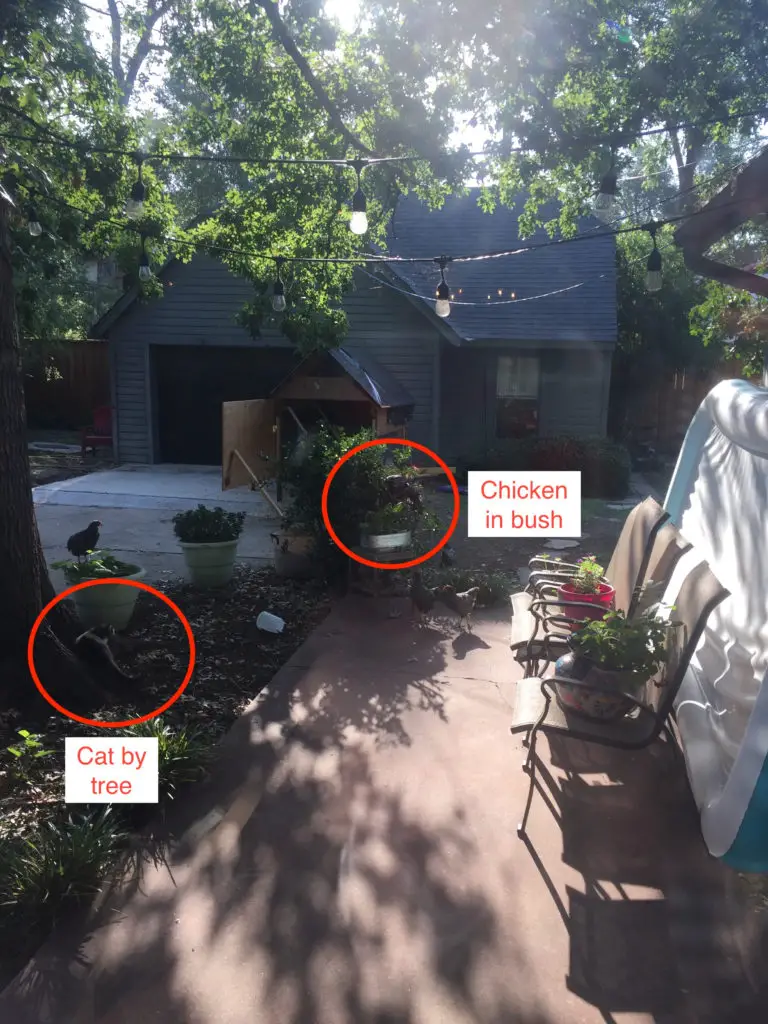
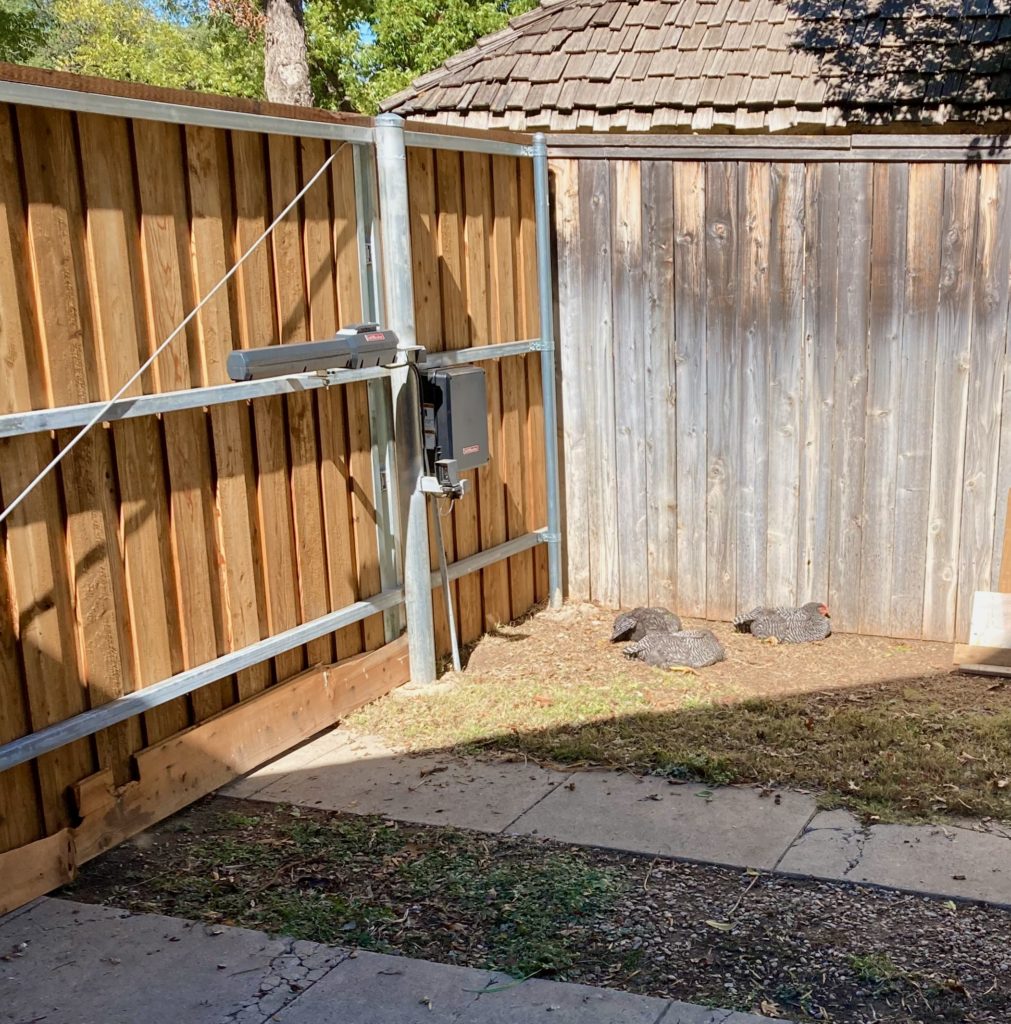
3. Keep your chickens in a run or chicken tractor during the day
The most practical way to keep your chickens in your yard during the day is by keeping them in a chicken run.
A chicken run is a fenced in area that has all sides and the roof made of fencing material. Chicken runs can be attached to one side of a chicken coop or can be large enough to house the entire coop.
I leave my chickens in their run attached to their coop during the day when I’m at work or will not be able to check on them often. They usually enjoy their time in the run but some days they get very restless and noisy.
Free ranging chickens are able to explore, scratch around, and do their run-flying through the yard. When chickens are in a run all day, they can get noisy.
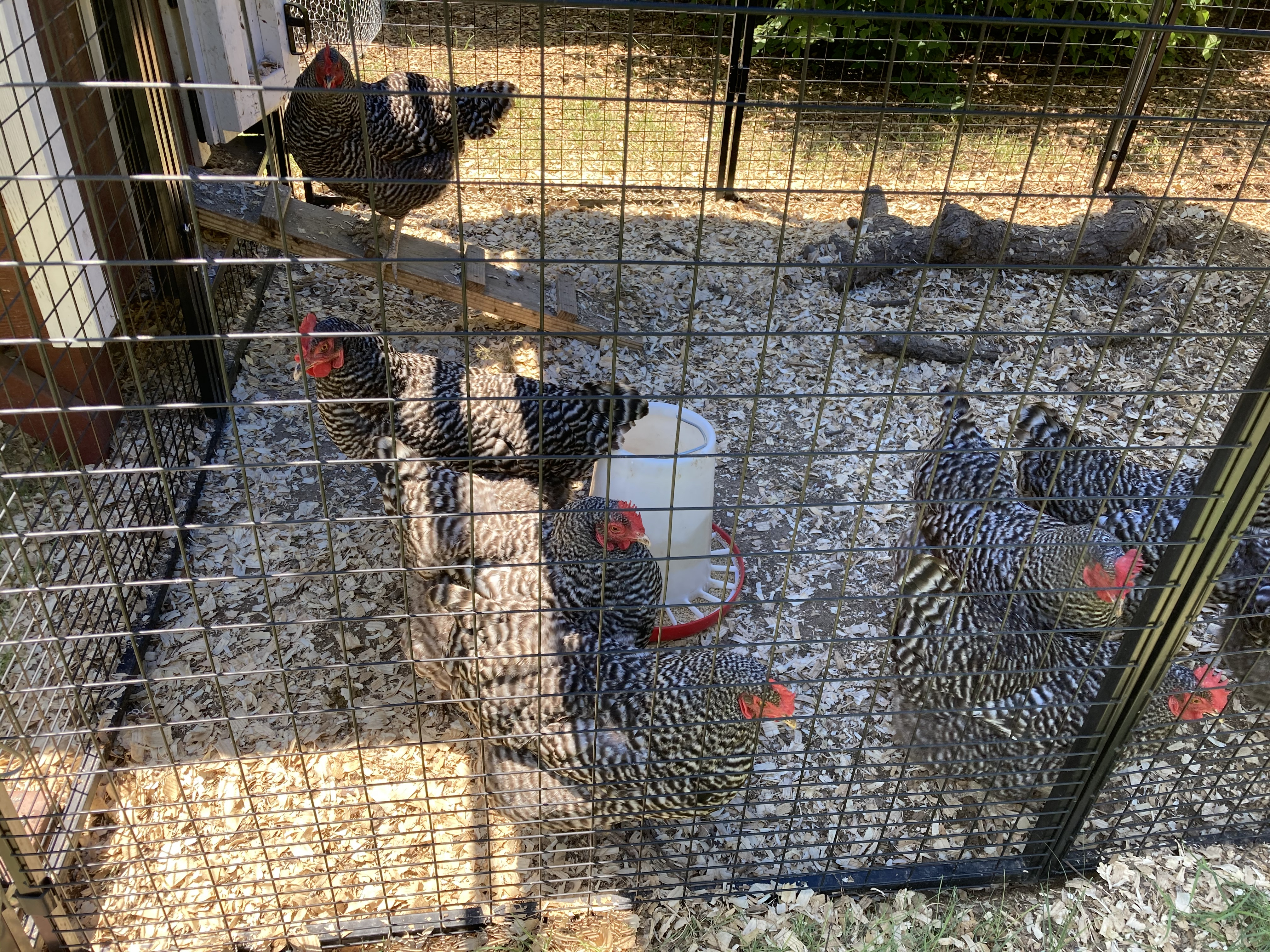
Chickens can get bored if there is not some type of enrichment activity for them to engage in during the day. Think of leaving a preschooler alone for hours and how they would get into everything if they didn’t have something to keep them entertained.
Consider adding a chicken swing or slide inside the run. Hang a head of iceberg lettuce or cabbage from the ceiling and let them play tetherball. Make sure there is plenty of food, water, and shade inside the run. Give your chickens scratch in the morning and leftovers at lunch to keep them busy throughout the day and less likely to get restless.
Check out this post for more ideas to keep your chickens entertained during the day.
Another way to keep chickens in your yard during the day is by keeping the chickens in a chicken tractor (sometimes also called a chicken ark). This is a lightweight frame with netting that keeps your chickens inside and is able to be moved around your yard.
I think chicken tractors are great for young chickens that have not started laying. They are able to experience the outdoors without fear of a cat carrying them off. However, when the chickens start laying you will need to consider a nest box situation inside the chicken tractor since they will not be able to go to the nest boxes in the coop.
Something to consider when using a chicken tractor is that it will need to be moved regularly to prevent your chickens from destroying the lawn.
Chickens can tear up grass by scratching and pecking in the same area all day. If you have an area of weeds in your yard, it’s a great idea to place the chicken tractor over this area, just make sure the weeds are not toxic to chickens.
Remember to make sure the chickens’ food and water is inside the chicken tractor since they will not be able to leave the tractor until you let them out.
Since chicken tractors are typically made of lightweight materials, like PVC pipes, and have netting, they can be easily caught up in a draft and blown away. Use tent stakes or some other type of tie-down to make sure the chicken tractor does not get moved.
Also, make sure that predators, like dogs, can’t easily find a way to get inside the tractor.
4. Install fencing if chickens free range
Chickens should be allowed to free range as often as possible since it’s good exercise and allows them to eat plants and bugs from the yard. To ensure their safety and keep them from getting into areas of the yard that are off limits, a fence is recommended.
A fence should be at least 48 inches tall to discourage chickens from flying over.
If you can go as tall as 60 inches, this would really do well to keep your chickens contained.
You can also consider adding a lightweight netting over the top of the fence. This is the same type of netting that gardeners use to keep wild birds out of their gardens and off their fruit trees. It can be found at most home supply stores. This material should discourage the chickens from trying to fly out.
We recently installed a quick fence to extend the space for our chickens to roam during the day. It was made with T-posts and standard 48 inch chicken wire. The first day the fence was up, the chickens were curious but stayed inside. However, on the second day I checked on the chickens after dinner and saw one girl standing by the coop on the other side of the fence. Then I saw another chicken dust bathing in the garden. When I opened the door to go put them up, another 4 chickens appeared and everyone of them started running towards me, chirping happily. Over half the chickens had made it to the other side of the fence. I initially thought they were flying over the fence until the following weekend when I saw them crawling under the fence to get out!
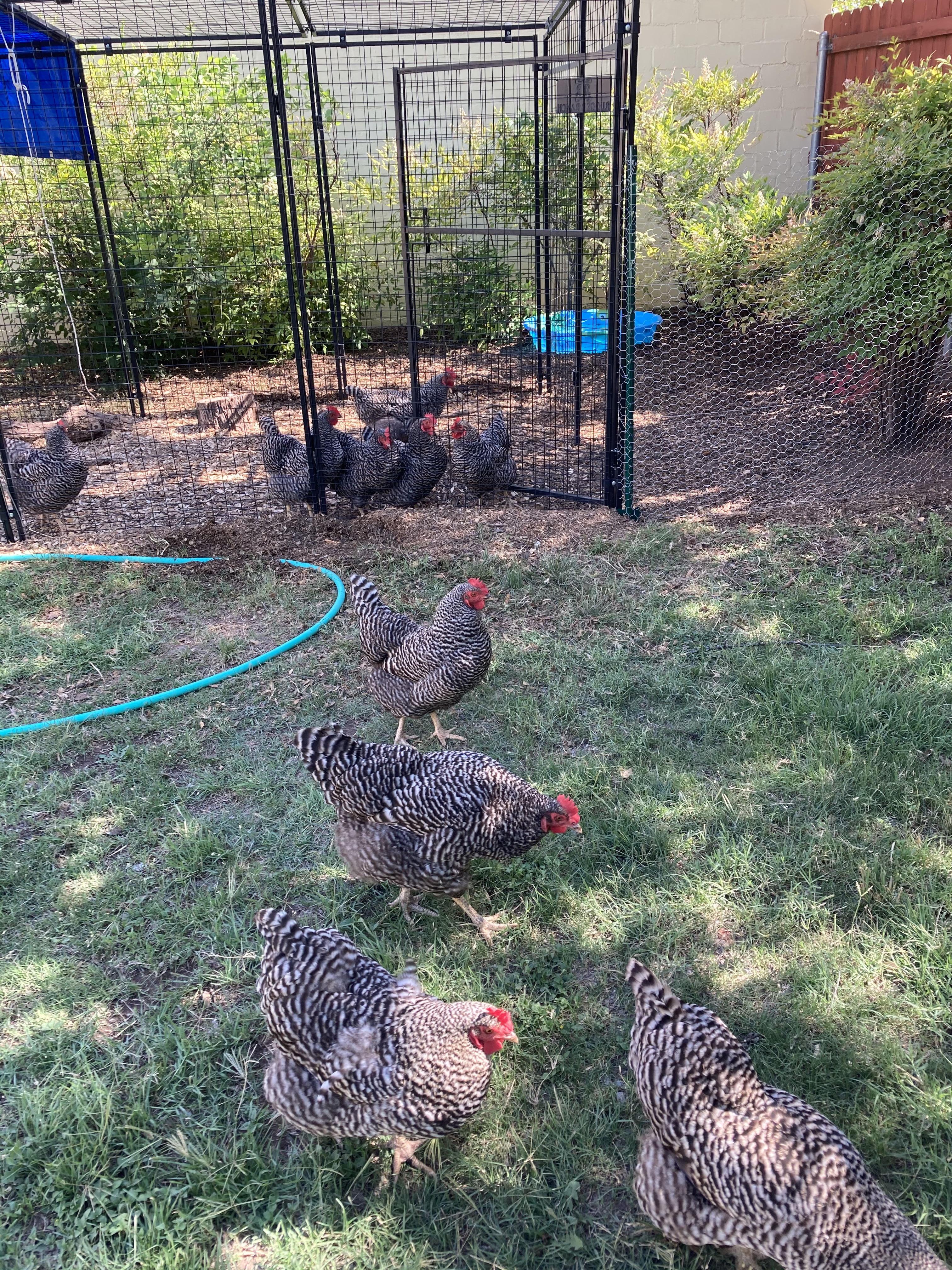
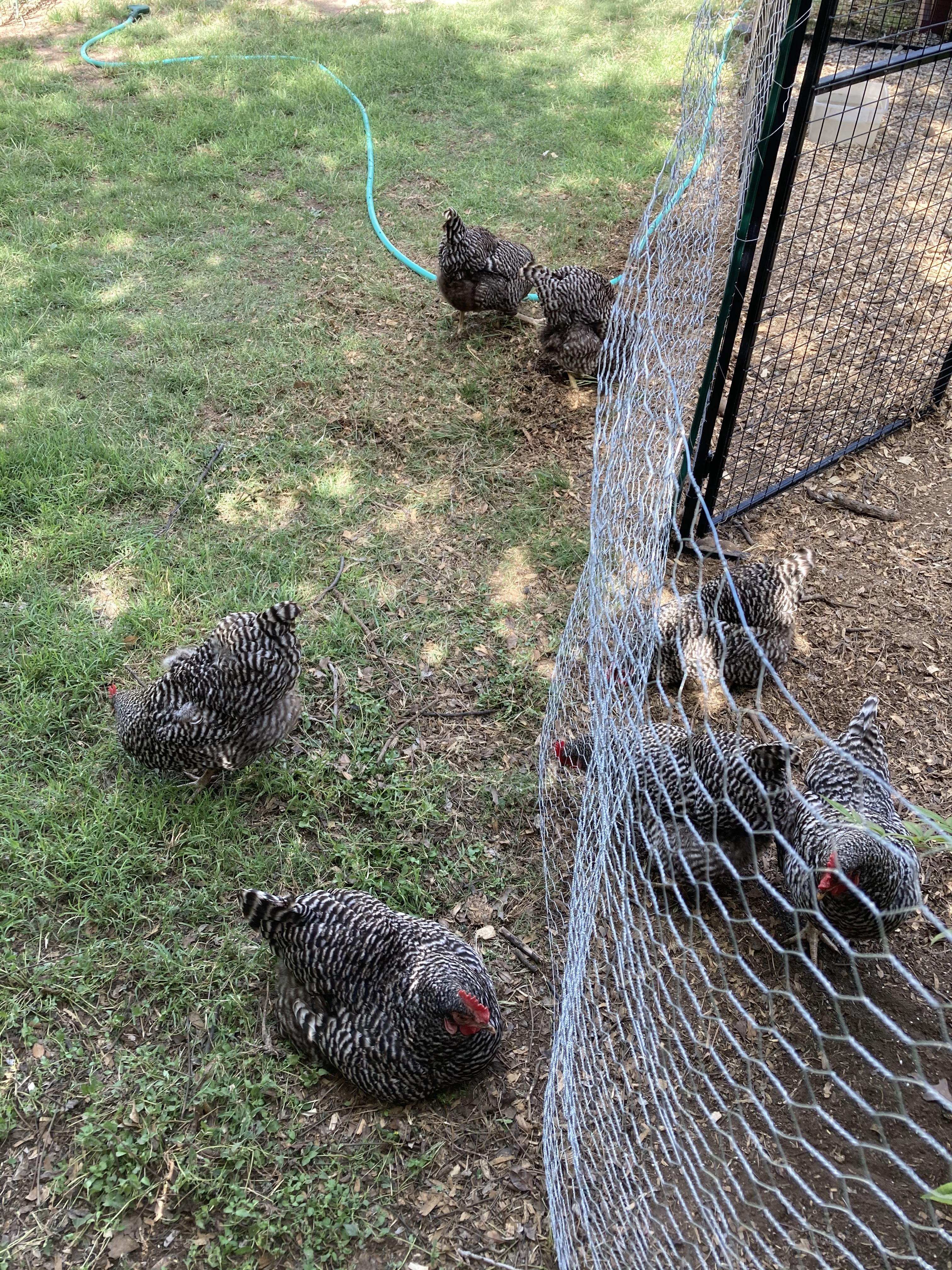
Make sure to periodically check the bottom of the fence or gate to make sure the chickens haven’t dug a hole to get to the other side.
My chickens enjoy dust bathing near the edges of the fencing which makes an indention in the ground. Once this indention gets deep enough, it takes minimal effort for the chickens to hunker down and crawl under the fence.
Safety tip: If your chickens can crawl under the gate, so can predators. Burying the fencing or adding a sill (such as scrap lumber) will prevent low spots in the fence where animals can crawl under.
Keep in mind that pullets are more likely to fly higher than mature birds.
When our chickens were just a few months old, I was looking out the kitchen window and saw one of my chickens in the next door neighbor’s crepe myrtle tree! She had either flown up to the top of the 7 foot fence or used the recycle bin as a stepping stone to get to the fence. From there, she jumped into the neighbor’s tree. On another day, I saw a chicken walking on the cap of the same 7 foot fence. I ran outside and shooed the chicken off the fence and into the backyard with a broom. Needless to say, pullets can fly and easily escape the yard. Make sure you are prepared for this because it was a total surprise to me.

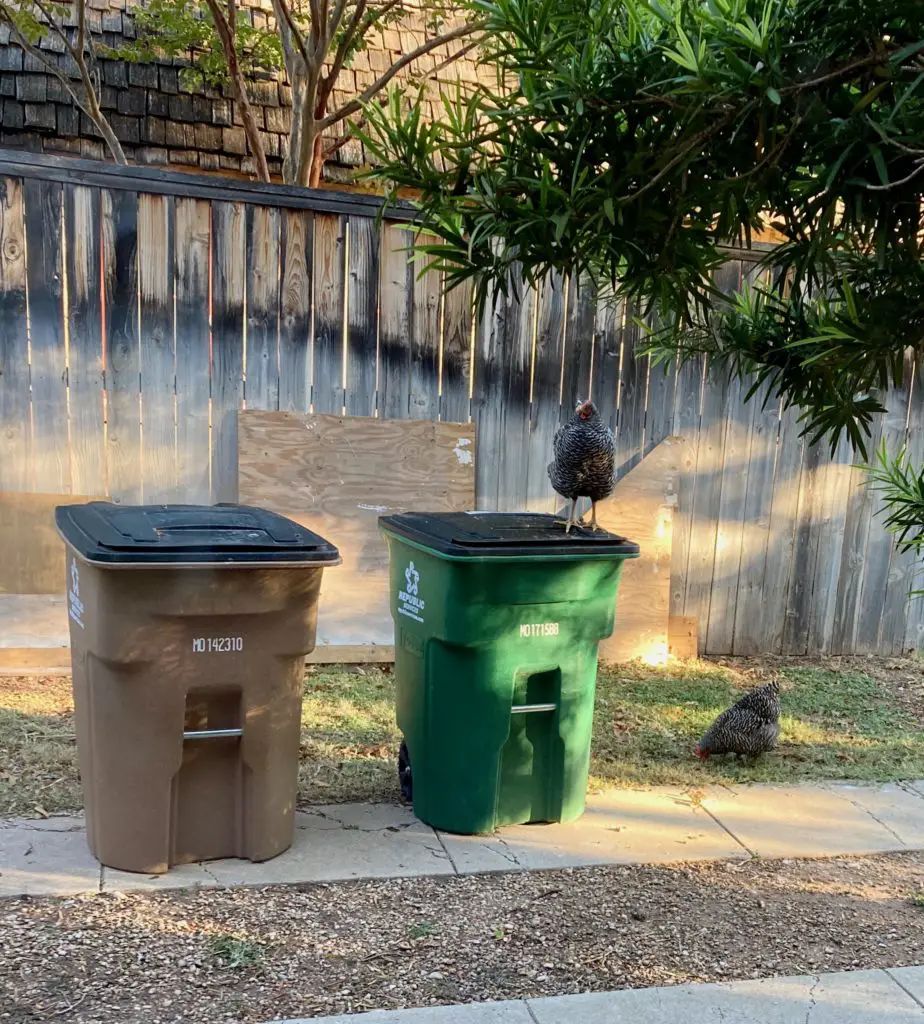
5. Clip their wings or add wing bands as a last resort
After all of the above suggestions are tried, some people will clip the chickens’ wings.
When a chicken’s wings are clipped, the flight feathers on one side of the chicken are cut off about an inch from where they emerge from the follicle. This will evidently affect the chicken’s balance enough to discourage her from flying over a fence but still allow her to fly up to a roosting bar.
Another control you can apply to a chicken’s wings is to wrap one wing with a soft band, or brail. This is called brailing and will evidently prevent the chicken from being able to fully flap her wings to fly. Make sure to remove the band often to allow the chicken to stretch her wings and prevent discomfort.
In my personal opinion, both of these options seem a bit excessive for backyard chickens but is an option that some people will consider. I want to make sure my chickens are safely in my yard but at the same time I want them to be able to escape a predator if one approaches them. I had a kitten when I was 5 years old that was declawed and he was attacked and killed by my neighbor’s dog. Since then, no other cats in my family have ever gotten declawed. We’ve been scratched by the cats but they are able to protect themselves when needed.
At the end of the day, you know your chickens better than anyone else. Each chicken has their own personality and what might work for my chickens might be totally futile for your chickens.
Experiment with different methods to keep your chickens safely in your yard and then share what worked with your fellow chicken enthusiast friends. We could all use good tips for our backyard chickens!


1 comment
[…] larger chickens will only take flight when they are excited or to fly over a fence. I wrote this post about keeping your chickens from flying since we did have a few chickens that liked flying when […]